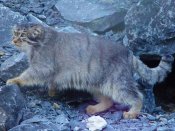 Palla's cats (Otocolobus manul) are small cats which range in the rocky areas and deserts from Iran to China and Mongolia. The Palla's cat's appearance a bit unusual with a broad head, tiny ears, big eyes, and stocky limbs. The Palla's cat's coat is longer than any of its relatives, and it is not of uniform color. It can be light-gray or a combination of yellow and brown.
Palla's cats (Otocolobus manul) are small cats which range in the rocky areas and deserts from Iran to China and Mongolia. The Palla's cat's appearance a bit unusual with a broad head, tiny ears, big eyes, and stocky limbs. The Palla's cat's coat is longer than any of its relatives, and it is not of uniform color. It can be light-gray or a combination of yellow and brown.It can be extremely silent when stalking. Its ability to move stealthily makes it a good predator. It is known to sneak up on its prey even with very few plants to hide in.
This cat is both solitary and a bit mysterious, Scientists do not know much about the Palla's cat, but from all indications, they appear to be night creatures. They hunt during the night relying mostly on excellent night vision. They hunt marmots, but mice are also a significant part of their diet.
Mating happens at the early part of the year, starting with many mating calls from both the males and females. The young are born blind, with a wooly covering. These kittens become autonomous at around eight weeks, and become sexually mature at 18 months of age.
The two largest threats to Palla's cats are humans, who hunt them, and an illness, called toxomoplasmosi, which is transmitted to younger cats from eating rodents.
The Pallas's cat is listed as Near Threatened (NT), is close to qualifying for or is likely to qualify for a threatened category in the near future, on the IUCN Red List of Threatened Species
Namings for the Pallas
A young / baby of a Pallas is called a 'kitten'. The females are called 'queen' and males 'tom '. A Pallas group is called a 'clowder, clutter, pounce, kindle (young), embarrassment (young),'.Countries
Afghanistan, Armenia, China, India, Iran, Kazakhstan, Kyrgyzstan, Mongolia, Pakistan, Russia, Tajikistan, Turkmenistan and Uzbekistan
Custom Search